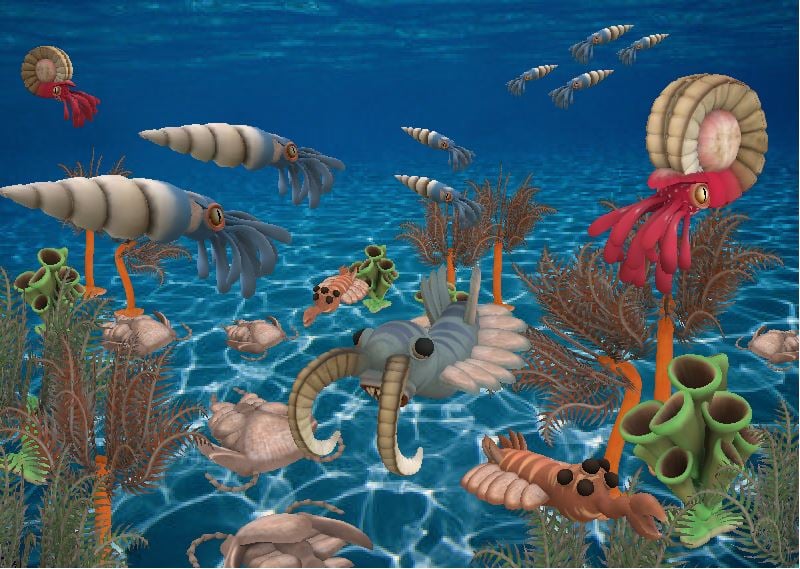Animal life exploded on Earth after oxygen built up over a 100-million-year period, and not the other way round, says an international team of scientists. The chicken-and-egg question has finally been answered, Dr. Philip Pogge von Strandmann, from University College London and colleagues wrote in the academic journal Nature Communications.
This latest study also answered the long-debated question regarding how long it took for Earth’s oceans and atmosphere to become oxygenated.
Dr. Pogge von Strandmann, a senior lecturer on isotope chemistry at UCL’s Department of Earth Sciences, and co-authors from the UK, USA and Denmark explained that the increase in oxygen levels started significantly earlier than had previously been thought, and took place in fits and starts over an extended period.
 First came the oxygen buildup, and then the explosion in animal life. (Image: i57.tinypic.com)
First came the oxygen buildup, and then the explosion in animal life. (Image: i57.tinypic.com)
They have therefore concluded that early animal evolution was prompted by rising oxygen levels, and not by a change in animal behaviour which brought about oxygenation.
Study helps explain why there is life on Earth
Dr. Pogge von Strandmann said:
“We want to find out how the evolution of life links to the evolution of our climate. The question on how strongly life has actively modified Earth’s climate, and why the Earth has been habitable for so long is extremely important for understanding both the climate system, and why life is on Earth in the first place.”
Researchers from UCL, the University of Bristol, and the University of Leeds in the UK; the University of Washington and Utah State University in the US; and the University of Southern Denmark, tracked oxygen levels from 520 million to 770 million years ago using new tracers in rocks across North America and China.
Samples of rocks that had been laid down on the seabed spanning hundreds of millions of years were taken from a number of locations to obtain a global picture of Earth’s oceanic and atmospheric oxygen levels.
100 million year oxygen accumulation
The team measured levels of selenium isotopes in the rocks and found that over a period of 100 million years, oxygen levels rose from less than 1% to over 10% of current levels.
 The accumulation of oxygen over a 100-million-year period led to an age of abundant animal life on Earth that continues today. (Image: cerebrovortex.files)
The accumulation of oxygen over a 100-million-year period led to an age of abundant animal life on Earth that continues today. (Image: cerebrovortex.files)
The team believes this was the most significant oxygenation event in Earth’s history, because it spurred an age of animal life that still exists today.
Dr. Pogge von Strandmann explained:
“We took a new approach by using selenium isotope tracers to analyse marine shales which gave us more information about the gradual changes in oxygen levels than is possible using the more conventional techniques used previously.”
“We were surprised to see how long it took Earth to produce oxygen and our findings dispel theories that it was a quick process caused by a change in animal behaviour.”
During the Smaller Gaskers glaciation of ~580 million years ago, the ‘snowball Earth’ Sturtian of ~716 million years ago, and the Marinoan of ~635 million years ago – three large glaciations – all the land on Earth was iced over and the majority of the oceans from the poles to the tropics were frozen.
 Dr. Philip Pogge von Strandmann’s research concentrates on the biogeochemical cycling of elements, and how that interacts with the climates of today and in the past. He is particularly interested in chemical weathering, soil formation chemical processes, and the effects of both on ocean chemistry. (Image: ucl.ac.uk/earth-planetary-institute)
Dr. Philip Pogge von Strandmann’s research concentrates on the biogeochemical cycling of elements, and how that interacts with the climates of today and in the past. He is particularly interested in chemical weathering, soil formation chemical processes, and the effects of both on ocean chemistry. (Image: ucl.ac.uk/earth-planetary-institute)
As glaciers melted nutrients were pushed into the sea
During those three periods, temperatures on Earth plummeted and rose again, causing glaciers to melt and push vast quantities of nutrients into the sea. Scientists believe this caused oxygen levels deep in the oceans to rise.
As nutrient levels in the oceans rose, so did plankton life, which buries organic carbon in sediments on the seafloor after death. When carbon was buried levels of oxygen rose, which dramatically transformed conditions on Earth.
Before this latest study, the majority of scientists had thought oxygenation occurred after the comparatively small Gaskiers glaciation.
However, the authors say their findings push it to an earlier period – to the Marinoan glaciation – after which animal life started to thrive and flourish in the more favourable conditions – this led to Earth’s first giant explosion of animal life.
Study co-author Professor David Catling, from the University of Washington’s School of Earth and Space Sciences, added:
“Oxygen was like a slow fuse to the explosion of animal life. Around 635 Ma, enough oxygen probably existed to support tiny sponges. Then, after 580 Ma, strange creatures, as thin as crêpes, lived on a lightly oxygenated seafloor.”
“Fifty million years later, vertebrate ancestors were gliding through oxygen-rich seawater. Tracking how oxygen increased is the first step towards understanding why it took so long. Ultimately, a grasp of geologic controls on oxygen levels can help us understand whether animal-like life might exist or not on Earth-like planets elsewhere.”
In an Abstract in Nature Communications, the scientists concluded:
“Overall, increased ocean oxidation and atmospheric O2 extended over at least 100 million years, setting the stage for early animal evolution.”
The study was financed by the Natural Environment Research Council (NERC), a UK Research Council that supports training, research, and knowledge transfer activities in the environmental sciences.
Article Reference: “Selenium isotope evidence for progressive oxidation of the Neoproterozoic biosphere,” David C. Catling, Philip A. E. Pogge von Strandmann, Don E. Canfield, Eva E. Stüeken, Tim Elliott, Simon W. Poulton & Carol M. Dehler. Nature Communications. Deccember 18, 2015. DOI:10.1038/ncomms10157.
